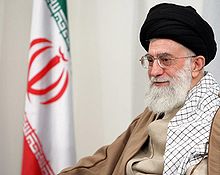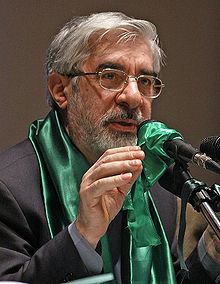- Government of Mir-Hossein Mousavi (1981–1989)
-
Ali Hoseyni Khamene’i
سید علی خامنه ای
President of Iran In office
13 October 1981 – 3 August 1989Prime Minister Mohammad-Reza Mahdavi Kani
Mir-Hossein MousaviLeader Ruhollah Khomeini Preceded by Mohammad Ali Rajai Succeeded by Akbar Hashemi Rafsanjani Personal details Born 17 July 1939
Mashhad, IranPolitical party Combatant Clergy Association
(1977–present)Other political
affiliationsIslamic Republic Party
(1979–1987)Spouse(s) Khojaste Khamenei (1964–present)[1] Children Mojtaba, Mostafa, Masoud, Maytham, Hoda and Boshra Religion Shia Islam Mir-Hossein Mousavi Khameneh
میرحسین موسوی خامنه
Prime Minister of Iran In office
31 October 1981 – 3 August 1989President Ali Khamenei Leader Ruhollah Khomeini
Ali KhameneiPreceded by Mohammad-Reza Mahdavi Kani (Acting) Succeeded by Position abolished Personal details Born 2 March 1942
Khameneh, IranPolitical party Independent Spouse(s) Zahra Rahnavard (1969–present) Children Kokab Mousavi
Narges Mousavi
Zahra MousaviResidence Niavaran, Tehran, Iran Alma mater National University of Tehran Religion Twelver Shi'a Islam Website kaleme.org Government of Mir-Hossein Mousavi was the third and fourth government of Iran after Iranian Revolution.On That time, Ali Khamenei was president and Mir-Hossein Mousavi was prime minister.
Contents
Khamenei's Presidency
Khamenei was a key figure in the Islamic revolution in Iran and a close confidant of Ayatollah Khomeini.[citation needed]
Khomeini appointed Khamenei to the post of Tehran's Friday prayers in the autumn of 1989, after forced resignation of Grand Ayatollah Hossein-Ali Montazeri from the post, when he criticised Khomeini for torture of prisoners. He served briefly as the Deputy Minister for Defence and as a supervisor of the Islamic Revolutionary Guards. He also went to the battlefield as a representative of the defense commission of the parliament. In June 1981, Khamenei narrowly escaped an assassination attempt when a bomb, concealed in a tape recorder at a press conference, exploded beside him. He was permanently injured, losing the use of his right arm.[2]
Candidate Votes % Ali Khamenei 16,003,242 95.02% Ali Akbar Parvaresh 342,600 2.03% Hasan Ghafourifard 78,559 0.47% Reza Zavare'i 62,133 0.37% Blank or invalid votes 356,266 2.12% Total 16,841,800 In 1981, after the assassination of Mohammad-Ali Rajai, Khamenei was elected President of Iran by a landslide vote in the Iranian presidential election, October 1981 and became the first cleric to serve in the office. Ayatollah Khomeini had originally wanted to keep clerics out of the presidency but later changed his views.[citation needed]
In his presidential inaugural address Seyd Ali Geda vowed to eliminate "deviation, liberalism, and American-influenced leftists".[3] Vigorous opposition to the regime, including nonviolent and violent protest, assassinations, guerrilla activity and insurrections, was answered by state repression and terror in the early 1980s, both before and during Khamenei's presidency. Thousands of rank-and-file members of insurgent groups were killed, often by revolutionary courts. By 1982, the government announced that the courts would be reined in, although various political groups continued to be repressed by the government in the first half of the 1980s.[4]
Khamenei helped guide the country during the Iraq-Iran War in the 1980s, and developed close ties with the now-powerful Revolutionary Guards. As president, he had a reputation of being deeply interested in the military, budget and administrative details.[2] After the Iraqi army was expelled from Iran in 1982, Khamenei became one of the main opponents of Khomeini's decision to counter-invade into Iraq, an opinion Khamenei shared with Prime Minister Mir-Hossein Mousavi, with whom he would later conflict during the 2009 Iranian election protests.[5]
He was re-elected to a second term in 1985, capturing 85.66% of total votes.[6]
Mousavi's Prime Ministership
In August 1981, President Mohammad-Ali Rajai and Prime Minister Mohammad-Javad Bahonar were assassinated in an explosion. Ali Khamenei was then elected as the third president of Iran in the Iranian presidential election, October 1981. He put forward Ali Akbar Velayati as his prime minister, but the Iranian parliament did not give him the vote of confidence, and he was defeated with a vote of 80 to 74.[7] Subsequently, Ali Khamenei, though he had strong disagreements with Mousavi, as a compromise with the left-leaning parliament, agreed to offer him, Mousavi, for the post of premier.[7] On October 28, the parliament approved Mousavi with a vote of 115 to 39.[8] Mousavi became the 79th prime minister of Iran on 31 October 1981,[9] and remained the prime minister of Iran until 3 August 1989, for eight years.[7]
The conflicts between Mousavi, who belonged to the left wing of the Islamic Republic, with Ali Khamenei (the current leader of Iran), who belonged to the right wing of the Islamic Republic, continued during their eight years of shared governance.[7] However, an escalation in conflicts between the two led to Mousavi's resignation shortly after the end of the Iran-Iraq war in 1988.[7] As the prime minister, Mousavi had the full backing of Ruhollah Khomeini, the supreme leader, and he refused to accept his resignation. Mousavi is remembered as leading a government that did not tolerate dissent.[10]
Mousavi's premiership coincided with the Iran-Iraq war. He guided the country through its war with Iraq, and earned popular acclaim for his stewardship of the national economy.[11] He pioneered a bond-based economy, which many believe was responsible for a fair distribution of goods among the people throughout the Iran-Iraq war.[12]
Many analysts praise his handling of Iran's economy, his civil and economic leadership during the Iran-Iraq War, and his efforts to end Iran's international isolation.[13] Others remember him as being "unpredictable" and less able to navigate Iran's labyrinthine political system than were his rivals.[14] In 1986, Mousavi played a great role in the Iran-Contra affair and secret negotiations and dealing with USA on helping them free the American hostages in Lebanon, in return for sale of the American weapons and spare-parts that Iran's army badly needed for Iran-Iraq War.[11]
Shortly after the end of Iran-Iraq war on 20 August 1988, Ruhollah Khomeini died, and Ali Khamenei was elected as the new Supreme Leader by the Assembly of Experts. Following his death, Mousavi and his fellow left-wingers lost their main source of support within the establishment.[7]
During the parliament hearing on post-war reconstruction plans, Mousavi had heated arguments with Ali Akbar Hashemi Rafsanjani, the speaker of Iran's parliament at the time, over Rafsanjani's suggestion that Iran accept the offer of western countries to help with post-war reconstruction.[10]
On July 28, 1989, the constitution was amended and approved by Iranian voters in a national referendum with a 97% yes vote. At this time, Mehdi Karrubi had been elected as the new speaker of the parliament, to whom the amended constitution was declared.[15] According to one of the amendments, the prime minister's position was abolished.[9]
Hashemi Rafsanjani was also elected as the fourth president of Iran on 28 July 1989 and became the president on 3 August 1989. Mousavi's premiership, ended on the same date.[9] He was the 79th and the last prime minister of Iran, since the constitutional revolution in 1906.
Mousavi was not invited to be a participant in the new government headed by Rafsanjani, and disappeared from the public sphere.[11]
Cabinet Members
First Cabinet
Ministry Minister Presidentl Ali Khamenei Prime Minister Mir-Hossein Mousavi Agricultural Mohammad Salamati Commerce Habibollah Asgaroladi Post Morteza Nabavi Culture and Islamic Guidance Abdol-Majid Moadikhah Defense and Armed Forces Logistics Mohammad Salimi Economy and Financial Affairs Hossein Namazi Education Ali Akbar Parvaresh] Energy Hossein Ghaforifard Foreign Affairs Ali Akbar Velayati Health and Medical Education Hadi Manafi Housing and Urban Development Mohammad Shahab Gonabadi Industries and Mines Mostafa Hashemi Intelligence Mohammadi Reyshahri Interior Kamaldin Nikravesh Justice Mohammad Asqari Labour and Social Affairs Ahmad Tavakkoli Petroleum Mohammad Qarazi Roads and Transportation Hadi Nejad-Hosseinian Science, Research, and Technology Mohammad-Ali Najafi Second Cabinet
Ministry Minister Presidentl Ali Khamenei Prime Minister Mir-Hossein Mousavi Agricultural Abass-Ali Zali Commerce Hossein Abedi Jafari Post Mohammad Gharazi Culture and Islamic Guidance Mohammad Khatami Defense and Armed Forces Logistics Mohammad-Hossein Jalali Economy and Financial Affairs Hossein Namazi Education Kazem Akrami Energy Mohammad-Taqi Banki Foreign Affairs Ali Akbar Velayati Health and Medical Education Alireza Marandi Housing and Urban Development Serajoldin Kazeroni Industries and Mines Behzad Nabavi Intelligence Mohammadi Reyshahri Interior Ali Akbar Mohtashamipur Justice Hassan Habibi Labour and Social Affairs Abolghasem Sarhadizade Petroleum Gholam Reza Aghazadeh Roads and Transportation Mohammad Saeedi Kia Science, Research, and Technology Mohammad Farhadi References
- ^ "Others 1992". Islam-pure.de. http://www.islam-pure.de/imam/others/others1992.htm. Retrieved 2009-06-19.
- ^ a b "Meet 'The Decider' of Tehran. It's Not the Hothead You Expect", Nasr, Vali, commentary article, Outlook section, Washington Post, December 9, 2007, page B01, accessed same day
- ^ Reading Khamenei by Karmin Sadjadpour
- ^ "History of Iran: Iran after the victory of 1979's Revolution". Iranchamber.com. http://www.iranchamber.com/history/islamic_revolution/revolution_and_iran_after1979_4.php. Retrieved 2009-06-19.
- ^ Karsh, Efraim (2002). The Iran-Iraq War 1980-1988. Oxford: Osprey Publishing. pp. 41. ISBN 1-84176-371-3.
- ^ : Khatami Museum :[dead link]
- ^ a b c d e f "زندگینامه نامزدها: میر حسین موسوی" (in Persian). BBC Persian. 21 May 2009. http://www.bbc.co.uk/persian/iran/2009/05/090521_og_ir88_mosavi.shtml. Retrieved 2009-06-21.
- ^ Iran under the ayatollahs, by Dilip Hiro, p. 198
- ^ a b c "Biography: Mir-Hossein Mousavi". Rianovosti. 09/06/2009. http://en.rian.ru/world/20090609/155210271.html. Retrieved 2009-06-21.
- ^ a b "Profile: Mir Hossein Mousavi". BBC. 16 June 2009. http://news.bbc.co.uk/2/hi/middle_east/8103851.stm. Retrieved 2009-06-21.
- ^ a b c Mousavi, Hossein Biography
- ^ "Iran’s ex-PM seen as candidate". FT. January 16, 2009. http://www.ft.com/cms/s/0/7e0997f4-e40f-11dd-8274-0000779fd2ac.html?nclick_check=1.
- ^ "Mir-Hossein: Attempt to Exit 20-year long Isolation? (میر حسین موسوی؛ تلاش برای خروج از انزوای ۲۰ ساله؟)," (in Persian). BBC. 3 March 2009. http://www.bbc.co.uk/persian/iran/2009/03/090303_mg_mir_hossain_mosavi.shtml.
- ^ Daragah, Borzou; Ramin Mostaghim, Kim Murphy (2009-06-22). "Mir-Hossein Mousavi's unusual career arc". The Los Angeles Times. http://www.latimes.com/news/nationworld/world/la-fg-iran-mousavi22-2009jun22,0,7316075.story. Retrieved 2009-06-22.
- ^ "تصویب قانون اساسی جمهوری اسلامی" (in Persian). IRNA news agency. http://74.125.153.132/search?q=cache:A9VvcDegiLMJ:www2.irna.ir/occasion/12azar84/indexghanon.htm+http://www.irna.ir/occasion/12azar84/indexghanon.htm&cd=1&hl=en&ct=clnk&gl=in&client=firefox-a. Retrieved 2009-06-21.
See also
- Mir-Hossein Mousavi presidential campaign, 2009
- Cabinet of Iran
Government offices Preceded by
Interim government of the Islamic RepublicGovernment of Iran
1981-1989Succeeded by
Government of Akbar Hashemi RafsanjaniMir-Hossein Mousavi Government (1981-1989) · 1997 presidential election · 2009 presidential election · 2009 presidential campaign · 2009 Iranian election protests · 2009 Iran poll protests trial · 2009 Iranian university dormitory raids · The Green Path of Hope · Green Movement · The Green Scroll Campaign

Cabinet of Iran Education · Communications and Information Technology · Information · Economic Affairs and Finance · Foreign Affairs · Commerce · Health and Medical Education · Cooperatives · Agriculture · Justice · Defense · Roads and Transport · Welfare and Social Security · Industries and Mines · Science, Research and Technology · Culture and Islamic Guidance · Labor and Social Affairs · Interior · Housing and Urban Development · Petroleum · Energy
Categories:- Government ministries of Iran
Wikimedia Foundation. 2010.
